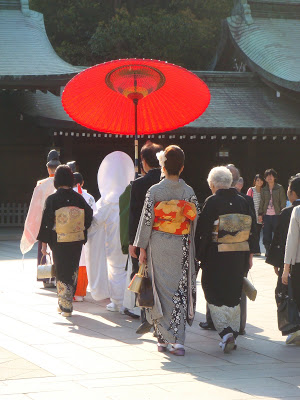
Asamidori sumiwataritaru ozora no
Hiokio onoga kokoro tomogana
.
“Blue sweep of heavens
Wide and clear—
Might my heart share
Their spaciousness!”
—Emperor Meiji
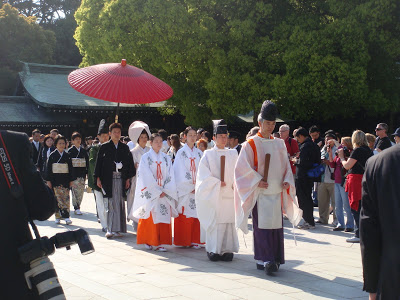 This traditional 31-syllable poem was composed by Emperor Meiji himself…or maybe Empress Shoken; no one’s quite sure. At the family’s shrine you can shake a canister until a stick falls out. This stick will have a number on it, which usually corresponds with some lucky numbers and a fortune, but here at Meiji Shrine, you get a poem!
This traditional 31-syllable poem was composed by Emperor Meiji himself…or maybe Empress Shoken; no one’s quite sure. At the family’s shrine you can shake a canister until a stick falls out. This stick will have a number on it, which usually corresponds with some lucky numbers and a fortune, but here at Meiji Shrine, you get a poem! 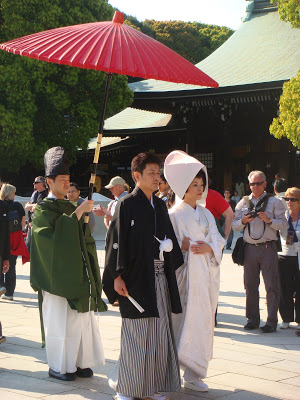 The first time I shook it the girl gave me a poem all in Japanese. “Sumimasen!” I said, “Eigoga wa arimaska?” Hopefully that meant, “Excuse me! Do you have it in English?” In retrospect it sounds similar to the words for, “Do you speak English?” so who knows. She looked confused, so I said, “English?” and she handed me a different canister to shake. Instead of the Japanese character numbers the stick had a 51 scrawled on it. My poem means to let your heart be open and spacious as the sky, even in the routine of daily life. I like it.
The first time I shook it the girl gave me a poem all in Japanese. “Sumimasen!” I said, “Eigoga wa arimaska?” Hopefully that meant, “Excuse me! Do you have it in English?” In retrospect it sounds similar to the words for, “Do you speak English?” so who knows. She looked confused, so I said, “English?” and she handed me a different canister to shake. Instead of the Japanese character numbers the stick had a 51 scrawled on it. My poem means to let your heart be open and spacious as the sky, even in the routine of daily life. I like it. 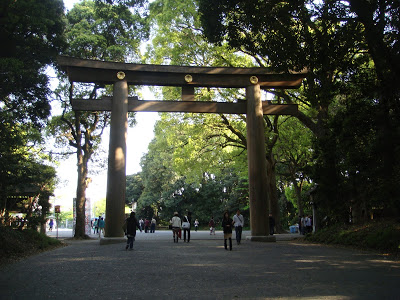
Wide and clear—
Might my heart share
Their spaciousness!”
—Emperor Meiji
 This traditional 31-syllable poem was composed by Emperor Meiji himself…or maybe Empress Shoken; no one’s quite sure. At the family’s shrine you can shake a canister until a stick falls out. This stick will have a number on it, which usually corresponds with some lucky numbers and a fortune, but here at Meiji Shrine, you get a poem!
This traditional 31-syllable poem was composed by Emperor Meiji himself…or maybe Empress Shoken; no one’s quite sure. At the family’s shrine you can shake a canister until a stick falls out. This stick will have a number on it, which usually corresponds with some lucky numbers and a fortune, but here at Meiji Shrine, you get a poem!  The first time I shook it the girl gave me a poem all in Japanese. “Sumimasen!” I said, “Eigoga wa arimaska?” Hopefully that meant, “Excuse me! Do you have it in English?” In retrospect it sounds similar to the words for, “Do you speak English?” so who knows. She looked confused, so I said, “English?” and she handed me a different canister to shake. Instead of the Japanese character numbers the stick had a 51 scrawled on it. My poem means to let your heart be open and spacious as the sky, even in the routine of daily life. I like it.
The first time I shook it the girl gave me a poem all in Japanese. “Sumimasen!” I said, “Eigoga wa arimaska?” Hopefully that meant, “Excuse me! Do you have it in English?” In retrospect it sounds similar to the words for, “Do you speak English?” so who knows. She looked confused, so I said, “English?” and she handed me a different canister to shake. Instead of the Japanese character numbers the stick had a 51 scrawled on it. My poem means to let your heart be open and spacious as the sky, even in the routine of daily life. I like it. 
About 10 weddings were going on. We saw an elderly western-looking man in Japanese traditional dress taking pictures with a woman in a ceremonial kimono. The sun was starting to set and lit up the sacred red umbrella as wedding processions marched through the shrine like a parade. I’m a little fuzzy on the details, but I think parasols are one of the eight auspicious signs of Buddhism and symbolize protection from harm; specifically, its shade is cooling against harmful desires. But this is Meiji Shrine, not temple, meaning it’s Shinto, not Buddhist. So…there you have it.

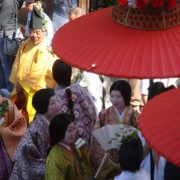 Aoi Matsuri, or Why We Didn’t See Kyoto’s Imperial Palace
Aoi Matsuri, or Why We Didn’t See Kyoto’s Imperial Palace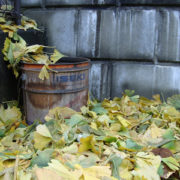 Room with a View
Room with a View The Navy Wife’s Guide to Confession, or Shameless Product Endorsement I Should Get Paid For…But Am Not
The Navy Wife’s Guide to Confession, or Shameless Product Endorsement I Should Get Paid For…But Am Not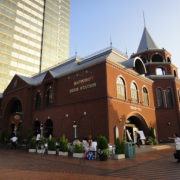 Oktoberfest Japan—Sapporo Beer Station
Oktoberfest Japan—Sapporo Beer Station
Just bumped into you blog! I love reading it! <3
Anyway I went to Meiji Jingu on 1st Jan for the first shrine visit of the year.
I have always loved this place 🙂
xx,
Shabrina